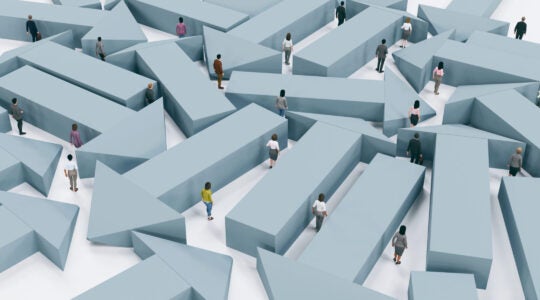Time was, one turned on the tube and invariably saw a Jewish comedian telling jokes to a national audience. Today, it is just as likely to be a Jewish religious ritual that pops up on the screen. And it’s not just Passover seders and Chanukah menorah lighting. From the shiva scene at the beginning of the 2005 movie “James White” (currently screening on Netflix), to the Tisha b’Av observance in Amazon Prime’s “The Marvelous Mrs. Maisel,” to the Jewish wedding scene in Fox’s “Family Guy,” representations of Jewish ritual have become mainstream in popular entertainment. Yet many of these are just snapshots — what the Australian scholar Jon Stratton, writing about “Seinfeld,” calls “Jewish moments” — rather than deep explorations of Jewish rites.
At the same time as Jewish rituals are proliferating in snipped-off form in pop culture, their length is often decreasing in real life as well, especially in non-Orthodox Judaism. Synagogue services are abbreviated, seders take place at breakneck speed and few mourners sit shiva for a full seven days.
Is art imitating life?
Lawrence Hoffman, an emeritus professor at Hebrew Union College in New York, told me that Jews nowadays “don’t want to spend a long time doing ritual. They don’t have the energy, patience, and commitment.” Rabbi Hoffman has argued for years that Reform services should be geared to the needs of the congregation rather than those of the clergy, and that even such core prayers as the Shema and Aleinu are dispensable if other aspects of the service are being highlighted. If services are too long, he said, people either don’t come at all or they leave early.
Even on the High Holidays, Rabbi Hoffman remarked, “they come for Kol Nidrei and that’s enough — they often don’t feel the need to come the next day.” This does not necessarily signal a lack of interest, he noted. “A ritual can be shorter, but people can bring a lot of investment to it.”
Indeed, according to the rabbi of a Conservative congregation in the Northeast, who prefers to remain anonymous, there are good reasons in many cases to foreshorten rituals. “Just because many people don’t sit a full shiva,” he said, “it does not mean that they are being dismissive of the ritual. Especially for a family that has had a prolonged period of hospice, they are burnt out and shiva doesn’t come as much of a comfort for them. They say that they’ve been sitting shiva for two weeks already.”
Convenience is increasingly a factor in the length of time that American Jews devote to religious observance. For Vanessa Ochs, an expert on Jewish ritual who teaches at the University of Virginia, “my Orthodox friends describe seven days of shiva as a nightmare. It’s arduous and exhausting to have to be available for visits for such a long time. No one can sit for that long — it causes a panic. What remains powerful is the getting up from shiva and walking around the block and having to re-enter life.”
Further, she pointed out, people are doing “super-speedy” seders, lighting the menorah at the beginning of Chanukah before losing interest and then “kicking back in” again at the end, and, in general, adapting Jewish ritual to their lifestyles rather than the other way around. “Rituals can be more efficient if you’re more knowledgeable,” she reflected, pointing to the hashkamah minyan (the sunrise Shabbat morning service, invented at the turn of the 20th century in order to enable factory workers to pray before going to work on Shabbat) as an example.
Even the hora at a bar or bat mitzvah is often shorter than it used to be, and it has moved closer to the end of the party, when some guests are heading out the door. Howie Teger, a longtime DJ who owns an entertainment company based in Rockville, Md., gives clients two options for the hora: the first lasts 6 ½ minutes and the second lasts 9 ½. “Most people, especially those who are less religious, prefer the shorter one,” he said, “which they supplement with the pop songs that they heard on the radio in Tel Aviv.”
And perhaps we are indeed being influenced by what we see in our pop culture, for both good and ill. Despite its brevity, the bar mitzvah scene in William Finn’s “Falsettoland,” which was revived on Broadway in 2016 (and broadcast on PBS a year later), is powerful because the rite takes place in an unusual context — the hospital room of the bar mitzvah boy’s father’s male lover, who is dying of AIDS.
According to Joel Berkowitz, a theater historian who teaches at the University of Wisconsin, “Reproductions of Yiddishkeit in popular entertainment are often laughably wrong, or right but shallow. Yet they tap into the audience’s experience of weddings that they’ve been to, shivas that they’ve been to, kaddishes that they’ve said. There’s a tremendous theatricality to those moments.”
Some would say the same of abbreviated real-life rituals; despite their shortcomings, they still pack a punch.
Ted Merwin covers theater for the paper. His column appears monthly.
The New York Jewish Week brings you the stories behind the headlines, keeping you connected to Jewish life in New York. Help sustain the reporting you trust by donating today.





